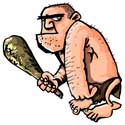 One sound you really don't want to hear in your bindery department is the sound of a hammer on a machine, unless you have a mechanic working in-house. Yet any moderately experienced bindery equipment operator will confess to using a 'convincer' to make an 'adjustment' at least once in his career.
One sound you really don't want to hear in your bindery department is the sound of a hammer on a machine, unless you have a mechanic working in-house. Yet any moderately experienced bindery equipment operator will confess to using a 'convincer' to make an 'adjustment' at least once in his career.
A common case of this arises when a tool gets stuck on a shaft, usually the scoring, perforating or cutting tools which fit on folding machines, cover feeders or scoring machines. Generally these accessories are designed to move freely, with finger pressure only. No hammer required--ever!
The fit on such accessories varies with manufacturer. Technifold tools for instance, are designed to have a tight sliding fit; they can move side to side with finger pressure yet there should be no wobble on the shaft. The upside to the tight fit is an extremely precise tool which yields a high-end result. The downside is that a buildup of dust and dirt or tiny dings on the shaft and/or tooling can cause the tool to stick on the shaft quicker than they would with a looser fitting tool.
Here are some tips to keep your bindery equipment running by preventing such a potentially expensive scenario. And if the sound of a hammer has you running from your office to the shop floor, and prevention is too late, we have a suggestion for that, too (other than a hammer to the head of the offending operator!)
Preventive Measures
- Clean all tools and shafts before you assemble...every time.
- If right from the start the fit is too tight to easily slide, NEVER force it on, hoping it will get better! I can almost guarantee damage will occur. Check for tiny dings, scratches, burrs or residue and clean or repair as needed, then try again...gently.
 Avoid the T-Handle allen wrenches and use the hand-grip style, ball end hex drivers (as shown in the photo) to avoid over tightening. Most folders come with this style hex driver. If all you have is a T-handle, just snug it up; you don't have to impress anyone with your superhuman strength here!
Avoid the T-Handle allen wrenches and use the hand-grip style, ball end hex drivers (as shown in the photo) to avoid over tightening. Most folders come with this style hex driver. If all you have is a T-handle, just snug it up; you don't have to impress anyone with your superhuman strength here!- ALWAYS use brass-tipped set screws. Regular set screws will damage the shafts and then you are out of luck.
- Replace set screws when they wear out or if they get damaged.
- Keep a clean rag handy and BEFORE you re-position any tools on the shafts, get in the habit of giving the shafts a quick cleaning, especially if you’ve been running a while. Small traces of paper dust and dirt will keep tight-fitting tools from moving...and out comes the hammer!
- Make sure you’ve loosened the correct set screw. Some tools have multiple set screws for various features. I’ve also seen tools that use two set screws to lock a device on the shaft—don’t forget to loosen the second one!
“It's Stuck, NOW What Do I Do?”
First clean the shafts and use fine emery in the vicinity of the stuck tool. Remove the set screw and drop a little oil in the tapped hole. Get out your hammer AND a wood block. With the wood block against the tool as protection, gently tap the wood block around the tool using the hammer.
If you can't get any movement in this manner, remove the shafts and take them to a local machine shop (or in-house maintenance if you have it.) They'll use the right tools to pull it off and repair any damage done.
Lastly, if the shafts on your finishing equipment are in visibly bad shape, consider replacing them. In most cases they're a lot less money than the tools you'll be using on them. As Garrison Keillor once said, what good is a "$50 haircut on a fifty cent head?"

